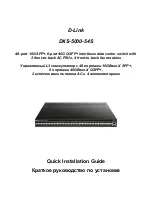
252
STA Bridges
◆
MSTI
– The Bridge Instance. This is also a link to the STP Detailed Bridge Status.
◆
Bridge ID
– A unique identifier for this bridge, consisting of the bridge priority, and MAC
address (where the address is taken from the switch system).
◆
Root ID
– The priority and MAC address of the device in the Spanning Tree that this
switch has been accepted as the root device.
◆
Root Port
– The number of the port on this switch that is closest to the root. This switch
communicates with the root device through this port. If there is no root port, then this switch
has been accepted as the root device of the Spanning Tree network.
◆
Root Cost
– The path cost from the root port on this switch to the root device. For the root
bridge this is zero. For all other bridges, it is the sum of the port path costs on the least
cost path to the root bridge.
◆
Topology Flag
– The current state of the Topology Change Notification flag (TCN) for this
bridge instance.
◆
Topology Change Last
– Time since the Spanning Tree was last reconfigured.
STP Detailed Bridge Status
– Click on a bridge instance under the MSTI field to display
detailed information on the selected entry. The following additional information is displayed.
◆
Bridge Instance
– The Bridge instance -CIST, MST1, ...
◆
Regional Root
– The Bridge ID of the currently elected regional root bridge, inside the
MSTP region of this bridge. (This parameter only applies to the CIST instance.)
◆
Internal Root Cost
– The Regional Root Path Cost. For the Regional Root Bridge this is
zero. For all other CIST instances in the same MSTP region, it is the sum of the Internal
Port Path Costs on the least cost path to the Internal Root Bridge. (This parameter only
applies to the CIST instance.)
◆
Topology Change Count
– The number of times the Spanning Tree has been reconfigured
(during a one-second interval).
CIST Ports & Aggregations State
◆
Port
– Port Identifier.
◆
Port ID
– The port identifier as used by the RSTP protocol. This consists of the priority part
and the logical port index of the bridge port.
◆
Role
– Roles are assigned according to whether the port is part of the active topology
connecting the bridge to the root bridge (i.e., root port), connecting a LAN through the
bridge to the root bridge (i.e., designated port); or is an alternate or backup port that may
provide connectivity if other bridges, bridge ports, or LANs fail or are removed.
◆
State
– Displays the current state of this port in the Spanning Tree:
Содержание GEP-1070
Страница 80: ...80 authentication from any point within the network...
Страница 168: ...168...
















































